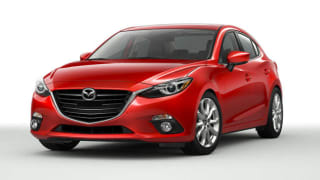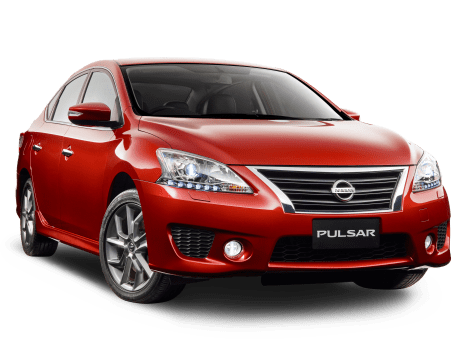
Mazda 3 2014 Review
With more than 3.5 million vehicles sold in the last 10 years the Mazda 3 is extremely important to the Japanese carmaker, no more so than in Australia where the ‘3 has been number one for the past tw
Browse over 9,000 car reviews

It seems to be the season for the return of old automotive friends. In the last few weeks we have attended the relaunches of Infiniti, Mirage, Astra, Barina (now called Corsa) and Beetle – and now the subject of this review, the all-new Nissan Pulsar.
It’s likely that over a million Australians have owned Pulsars – 250,000 as proud new car buyers and the balance buying them as used cars as they changed hands several times over the past four decades.
Nissan Pulsar has had a mixed history in Australia; though Japanese sourced it was once built in Melbourne and shared parts with Holden’s Astra. Most were fully imported from Japan. Some were called the Nissan Tiida instead of Pulsar – much to the disgust of those charged with the task of selling the car with the bizarre name with the double ii.

Now called the Pulsar again, and this time around made in Thailand, the all-new Nissan looks set for the long haul in Australia and even stands a chance of becoming the number one selling vehicle in this country.
Don’t believe us on that latter statement? Consider this, the biggest selling car in Australia for the last two years has been the Mazda3, one of the Pulsar’s closest competitors. The Mazda3 is getting on in years and the all-new Pulsar and its arch-rival Toyota Corolla wouldn't mind nudging it aside.
The biggest selling point of the new Nissan Pulsar is that it’s priced at $19,990 – the same price as listed way back in 1996. Since then the Pulsar has grown in size and now comes with far more in the way of luxury and safety equipment than it did 17 years ago. The high value of the Australian dollar comes into the equation but the aforementioned tough tussle at the front of the sales race certainly comes into play as Nissan chases buyers.
Even the lowest cost model, the $19,990 Pulsar ST manual, has 16-inch alloy wheels; cruise control; a six-speaker stereo with MP3, and Aux jack; keyless entry; and power windows and mirrors. This is far from being a stripped-down model and may have all the fruit that many buyers need.
Paying an extra $3660 puts you into a Pulsar ST-L which has front foglights: a rear spoiler; different 16-inch alloy wheels; and daytime running lights. Inside, there’s a higher level of cloth trim; leather details on the steering wheel; USB connectivity; a colour screen for the infotainment system; and fancier facings on the dashboard;
The topline $28,990 Nissan Pulsar Ti adds 17-inch alloys; leather trimmed interior; satellite navigation; and dual-zone air conditioning. The Ti comes as standard with a CVT automatic transmission, whereas you have to pay $2250 extra to get that unit over and above the price of the six-speed manual in the lower grades.
On-road costs have to be factored into all these prices.
Probably the biggest feature of the all-new Nissan Pulsar is its interior space. There’s excellent legroom in the rear and my six-foot frame was quite comfortable when sitting behind itself – if that doesn’t sound too Irish. Most cars in the next segment up from the Pulsar don’t have that much rear space and this Nissan could easily act as a full-size family car even if the kids have hit the huge-teen stage.
The boot is very large at 510 litres, again making the Pulsar more than suitable for use as a family sedan.
Power comes from a 1.8-litre four-cylinder engine developing up to 96 kilowatts of power. Peak torque comes in at a sky-high 4800 rpm where it’s an impressive 174 Newton metres.
The high revs required to get the maximum grunt out of the engine are somewhat misleading and during our introductory road testing out of Melbourne we found the engine pulled strongly from 2500 rpm and even worked smoothly at just 1500 rpm if you didn’t want it to accelerate hard. It’s happy to hold onto gears when climbing all but the steepest of hills.
Primary safety gear in all Pulsars includes VSC and ABS with brake assist and electronic distribution. Secondary safety sees the fitment of six airbags.
Ride comfort is pretty good, though the Pulsar did get bumped around by some poor quality Aussie back roads. Tyre noise on all but coarse-chip surfaces was minimal, with the Nissan being particularly smooth and quiet on good quality motorways.
Handling is competent enough, without actually having any pretensions to sportiness. Those wanting the latter will have to join the queue of keen drivers waiting for the return of the Pulsar SSS late in 2013. This will have a turbocharged 1.8-litre engine developing 140 kW, as well as sports tuned suspension and steering.
At this stage all new generations Nissan Pulsars have a four-door sedan body, five-door hatches will begin importation in May or June. Prices and specs on these haven’t yet been made public.
A car with a full-sized interior, reasonable performance and good build quality for only $19,900? We can see the new Nissan Pulsar selling up a storm.
| Vehicle | Specs | Price* | |
|---|---|---|---|
| ST-L | 1.8L, —, 6 SP MAN | $6,930 – 9,790 | 2013 Nissan Pulsar 2013 ST-L Pricing and Specs |
| ST | 1.8L, —, CVT AUTO | $7,480 – 10,560 | 2013 Nissan Pulsar 2013 ST Pricing and Specs |
| ST-S | 1.6L, —, 6 SP MAN | $7,810 – 11,000 | 2013 Nissan Pulsar 2013 ST-S Pricing and Specs |
| ST | 1.8L, —, 6 SP MAN | $6,930 – 9,790 | 2013 Nissan Pulsar 2013 ST Pricing and Specs |
$3,000
Lowest price, based on 125 car listings in the last 6 months